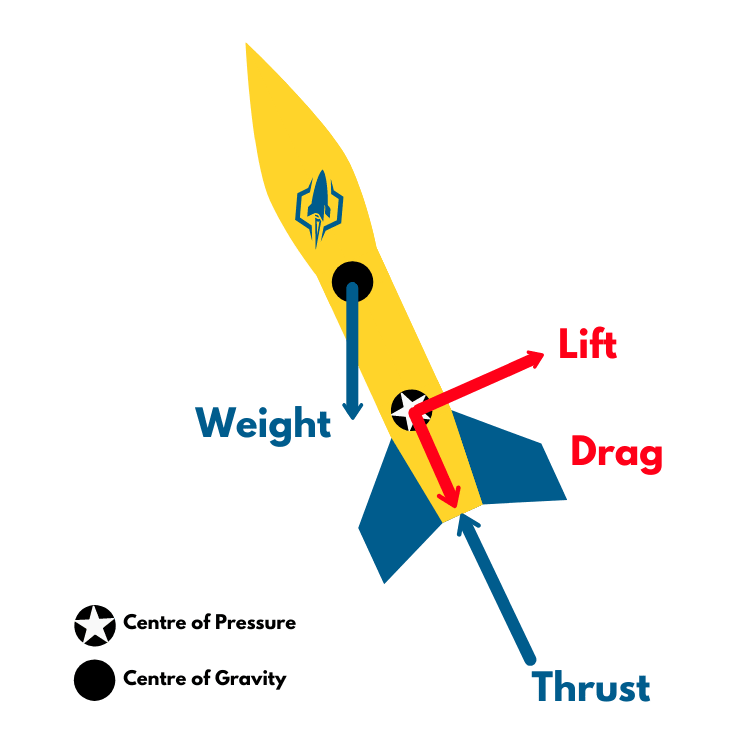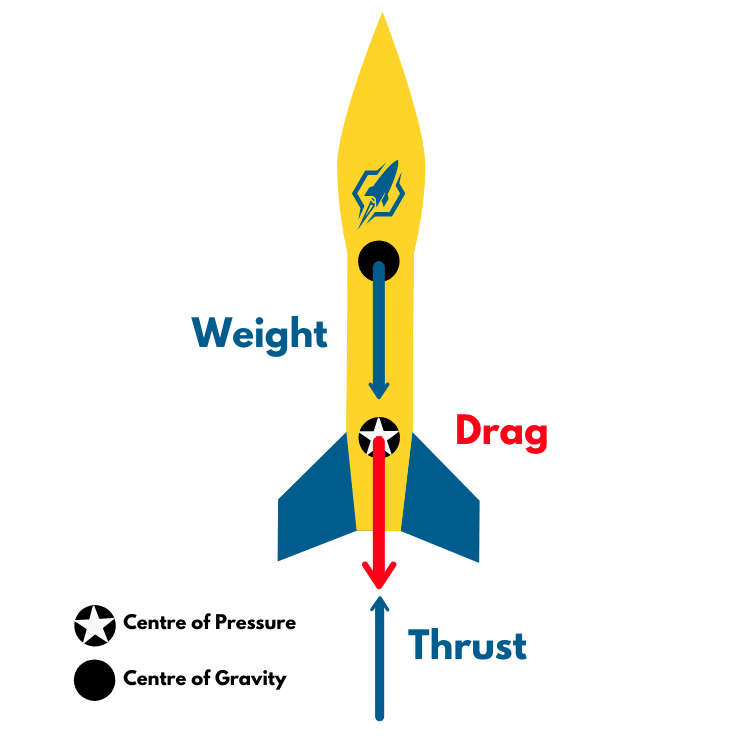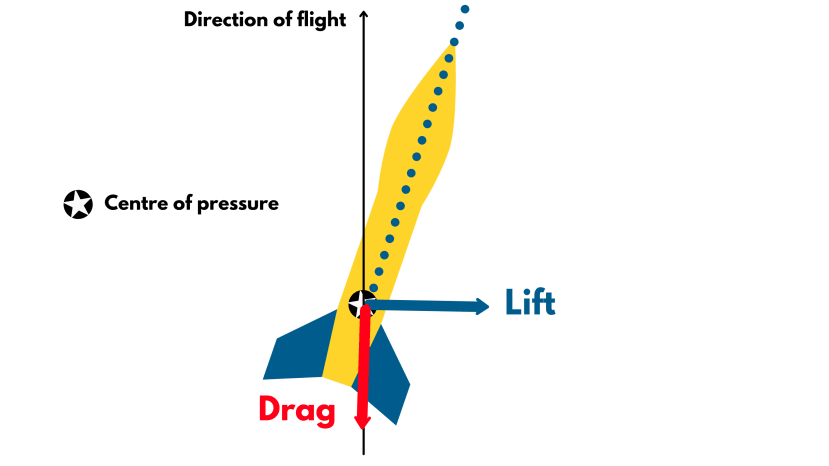Rocket Aerodynamics - Sutton Program Article 5
Follow articleHow do you feel about this article? Help us to provide better content for you.
Thank you! Your feedback has been received.
There was a problem submitting your feedback, please try again later.
What do you think of this article?
This article will accompany the fifth video in our series made possible by RS Components Grass Roots aiming to introduce key rocketry concepts and principles. This article will introduce various principles of aerodynamics that must be considered for rocket flight, showing how different types of drag are generated and some of the engineering techniques used to circumvent them. Written by Kieran Webb and Sean Clark
Introduction
Aerodynamics is the way in which objects move through the air, and its effects apply to any body regardless of size. For rockets and planes, the manipulation of air around its surfaces is crucial, as this will impact the body’s altitude, direction and speed.
To understand why aerodynamics is so important in rocket design, we first need to look at the four forces of flight in their most basic form.
Four forces on a rocket
The four forces on flight have been introduced in our article on Rocket Dynamics. Here is a more detailed breakdown of each of each of the main forces.
A rocket is subject to a total of four main forces during flight, each which act with a given direction and magnitude due to force being a vector quantity. The balance of these forces dictates the rocket’s movement through the air. The four forces (along with its corresponding symbol in brackets) are as follows:
The gravitational forces act through the centre of gravity of the rocket, or the point at which the average weight of the rocket acts, and are as follows:
- Weight (W) – this force depends upon the total mass of the rocket (m), along with the gravitational field strength (g) of the body from which the rocket launches. For planet Earth, ‘g’ is equal to 9.81 metres per second squared, or 9.81ms-2. The distribution of weight within the rocket will determine its centre of gravity.
- Thrust (T) – the thrust of a rocket is the total propulsive force produced by the engine, which depends upon the velocity, pressure and mass flow rate at the rocket’s nozzle.
The aerodynamic forces act through the centre of pressure of the rocket.
- Lift (L) – this is produced by air interacting with the solid body of the rocket- the air is pushed in one direction and, because of Newton’s third law, an equal force is produced in the opposite direction. This force is very important for a rocket’s stability, and always acts perpendicular to the direction of the oncoming flow.
- Drag (D) – for simplicity, this force can be described as ‘aerodynamic friction’ and has two main components- parasitic drag and induced drag.
The main difference between how we treat drag on a rocket and drag on an aircraft. On an aircraft such as a plane, lift is the force which opposes the plane’s weight and thus keeps the body airborne, as the lift force is directed perpendicular to the oncoming flow. This is different to a rocket, where thrust is the main force opposing weight, and lift is used to stabilise the rocket during flight.
The Drag Race
An easy way to visualise the principle of drag is to think of the resistance you feel as you try to move through a body of water - the water makes it much more difficult for you to move through it in comparison to moving through air. If the water is moving towards you at the same time, it becomes even more difficult to move forward.
The interaction between your body and the water is very similar to the interaction between a rocket and the air it moves through. The amount of drag on a body also depends on its surface area - in the context of a sailboat, drag is used positively. The larger the sail, the faster the boat moves as it harnesses more wind.
There are two main types of drag to consider, parasitic drag and induced drag.
Parasitic Drag
Parasitic drag is a type of drag that acts upon an object moving through a fluid and is split into two subcategories- Skin friction and Form Drag.
As mentioned above, the size of a sail will have an effect on the boat’s speed- this principle ties in directly with form drag. Form drag can be thought of as resistance to the motion of an object through a fluid and is caused directly by the size and shape of an object. We can think of the body as ‘punching a hole in the air’, this creates empty space (region of low pressure) directly behind the object. We know that the air naturally rushes to neutralise areas of high or low pressure so the low-pressure zone is now drawing anything close by into the void- including the body.
Unlike a sailboat, a high amount of form drag is detrimental to efficient rocket flight and thus many rockets are designed to be as slim and streamlined as possible. In order to do this, we can calculate a very useful property- the drag coefficient. To do this, we must first understand the drag equation, which determines the overall drag acting upon a body in a free stream:
D = 0.5 * Cd * V2 * ρ * A
- D = Total drag force
- Cd = Drag coefficient
- V = Velocity of the flow relative to the object
- ρ = Density of the fluid
- A = Reference Area
This equation can be helpful by itself, however it is affected by a number of very complex dependencies, such as air viscosity, body shape, inclination and compressibility. Individually these properties are very difficult to calculate and so we can lump them into one value- Cd, the drag coefficient, which allows us to keep all of the dependencies together, simplifying the equation. Engineers use simulation software to try and optimise the rocket’s cross sectional area A in order to make the Cd as low as possible.

Skin Friction is a result of the interaction between a fluid and a solid surface and depends upon the viscosity of the fluid. We can express this in terms of the Reynolds number (or Re) which indicates the flow properties. A high Reynolds number indicates a turbulent flow (a rougher flow) and a lower Reynolds number indicates a more laminar flow (a smoother flow). The roughness or smoothness of the flow is directly affected by the physical geometry of the surface it flows over- a rough surface will make the flow more turbulent and a smooth surface will aid laminarity. As rocket engineers wish for a more laminar and smooth flow, we used smooth and curved geometries for components such as the nose cone, body and fins.
Induced Drag
Induced drag is an inevitable consequence of lift generation and is directly caused by the deflection of air. An object at a large angle relative to the oncoming flow of air (angle of attack) will displace more air than one with a smaller angle but will also generate more lift. Increasing the angle of attack will increase the amount of lift produced (up to a given point) proportionally with the induced drag. This is why most aircraft tend to climb in the air at a smaller angle relative to the oncoming flow, as this minimises the induced drag produced so the ascension to cruise altitude is more efficient.
L = 0.5 * CL * ρ * A * V2
- L = Lift
- CL = Lift coefficient
- ρ = Fluid density
- A = Reference area
- V = Flow velocity relative to object
This equation may look complicated, but they are mostly constants that depend on the geometry of the aircraft and the others are known during flight so, with the addition of a flight plan, it is possible to calculate the induced drag that the aircraft will experience over the course of the flight. The lift coefficient includes lots of complicated terms which have been lumped together in order to simplify the equation, these are usually found through experimentation.
How can we reduce induced drag?
To reduce the lift induced drag, the lift can be reduced or the amount of drag caused as a direct result of lift can be reduced. This can be done by manipulating flight parameters or the rocket geometry. As the rockets altitude increases the forces of lift and drag will decrease proportionally to the density – the air becoming ‘thinner’ as you come closer to the edge of the atmosphere.
This can be thought of as an object travelling through water, the higher density relative to air means that it will be more difficult to move, this is due to the increased drag. The opposite of this is happening to a rocket through the course of its flight, the density decreases meaning drag decreases, but lift will also decrease meaning that the fins have less capability to stabilise the rocket as its altitude increases.
Applying the principles
Now that we have covered the four forces of flight, let’s have a look at how these apply to a rocket. If we first take a rocket straight after launch, it is orientated such that thrust acts in the direction of flight hence rendering the angle of attack and the lift to zero (as well as induced drag). This is shown on the diagram below. Opposing the thrust are the weight and drag forces. Looking at the rocket in this way shows how hugely impactful drag can be on the performance of a rocket and how very important the aerodynamic design is to try and minimise this. This is why engineers design components like the fins and nose cone to minimise the total amount of drag created, and therefore allow the rocket to move faster and with less resistance.
If we look at a rocket during flight, we can see that the rocket thrust is not always coincident with the oncoming flow. This means that there now must be an angle between the rocket and the oncoming airflow, so lift is produced. This can be generated by components like the nose cone and body tube; however, the majority is produced by the fins in the case of a model rocket.
Relatively, the fins on a rocket are much smaller than the wings of an aeroplane, this is because while the wings of an aeroplane are responsible for providing the lift and maintaining altitude, this job is primarily done by the thrust of rocket. The fins which produce the lift on a rocket do not need to produce the same magnitude of lift force as they are only responsible for maintaining stability and control of flight direction.
As lift and drag are aerodynamic forces and so are a result of the rocket’s interference with air, once in space there will be no lift or drag. This means that the direction of the rocket is completely controlled by thrust.
A word on stability
In order for a rocket to be stable, the centre of pressure needs to be closer to the tail end than the centre of gravity. If these two points were too close, the rocket would tumble out of control. Stability increases as the distance between these two points increases. This is why many rockets use fins at the tail end, this moves the centre of pressure downwards away from the centre of gravity.
During flight, rockets are subject to small gusts of wind which cause wobbling, which threatens to push it off-course. These small gusts cause the rocket to rotate about its centre of gravity, causing the centreline of the rocket to become slightly displaced. This generates a lift force, which acts perpendicular to the oncoming flow which, along with the drag, attempt to rotate the rocket back toward the flight direction- this is called the restoring force, which can only exist is the centre of pressure is located below the centre of gravity.
Once this restoring force acts, we can determine the rocket to be stable. This restoring force is much more important on smaller scale model rockets, like GU Rocketry’s Saltire-1, whereas larger rockets can use a technique known as thrust vectoring, which tilts the exhaust nozzle to correct for any rotations caused by gusts. This is why you do not see fins on larger-scale rocket boosters.
Conclusion
Aerodynamics is the most important aspect of rocketry to consider for a rocket in atmospheric flight- everything that exists within the domain of aerodynamics will affect a rocket’s flight path and efficiency, especially within small scale rockets. Once again, NASA has an excellent educational library with easy-to-follow courses on other aerodynamic principles. Aerodynamics is a wide branch of rocketry and requires a deep level of understanding to apply said principles in a real-world context. Thanks for reading, and happy learning!
Parts in this series:
- An Introduction to GU Rocketry
- The History of Rocketry - Sutton Program Article 1
- Rocket Dynamics - Sutton Program Article 2
- The Rocket Equation - Sutton Program Article 3
- Rocket Propulsion - Sutton Program Article 4
- Rocket Aerodynamics - Sutton Program Article 5
- Rocket Avionics - Sutton Program Article 6
- Rocket Recovery - Sutton Program Article 7






